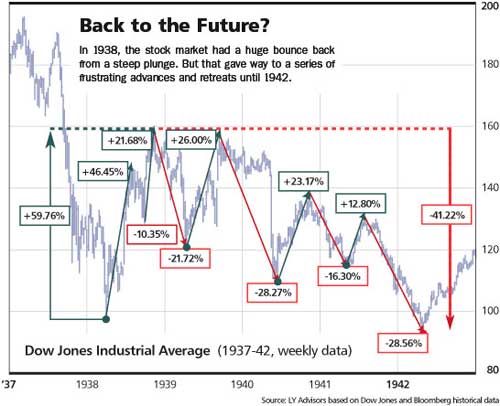Louise Yamada, Managing Director of her LY Technical Research Advisors and the doyenne of technical analysts, has a very interesting chart that points to 1938 as an antecedent for this year’s action.
From Barron’s:”It is almost uncanny the degree to which 2002-08 has tracked 1932-38,” Yamada writes in her latest note to clients. She has posited in her so-called Alternate Hypothesis that the structural bear market would be less like its most recent predecessor, from 1966-82, and more like 1929-42.
So the dot-com collapse parallels the Great Crash and its aftermath, followed by a rather nice recovery in 2003-07, similar to 1933-37. The parallels continue, with the collapse from late last year into this March tracing a similar, sickening trajectory to late 1937-38, as illustrated in Louise’s chart nearby. That drop led to a strong reaction rally, not unlike the current one, for a total gain of 60%. But that was broken into three segments: an initial rally of 46%, similar to the move from the March lows. Then we saw a 10% pullback, not unusual in a rally, then another gain of 22%.

From there comes the hard part. Starting in November 1938, there was a 22% drop, qualifying for the 20% rule-of-thumb definition of a bear market; then a rally of 26%, fitting the definition of a bull market, into the fateful month of September 1939, the start of World War II.
Then came a series of bull and bear trades — down 28%, up 23%, down 16%, up 13%, and the final decline into 1942 of 29%. After this nauseating roller-coaster ride, the market was down 41% from the 1938 highs (analogous to where we are now) to the 1942 lows.
emphasis added
We hope that the market is positioned more like 1983 than 1938. By 1983, indexes had begun a great run toward the mid-to-late 90’s.
Graph: Barrons
- Bulenox: Get 45% to 91% OFF ... Use Discount Code: UNO
- Risk Our Money Not Yours | Get 50% to 90% OFF ... Use Discount Code: MMBVBKSM
Disclaimer: This page contains affiliate links. If you choose to make a purchase after clicking a link, we may receive a commission at no additional cost to you. Thank you for your support!

Leave a Reply